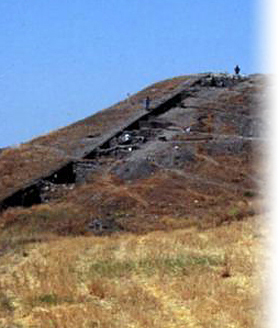
|
Site ChronologyThe following table provides a chronological outline of the site's settlement as revealed in archaeological efforts undertaken at Çadır Höyük between 1993 and 2008. Please note that the phases of occupation are numbered in ascending order, on the assumption that we have exposed all the major phases that we will find (with the possible exception of the Neolithic) from earliest to latest (I-X). The subphases, on the other hand, are lettered in descending order on the assumption that additional subphases may be uncovered below those already accounted for. We emphasize that while this is a preliminary chart and is susceptible to change and organization, it does reflect our current understanding of Çadır Höyük's historical development.*
|
| Period | Place | Dates/Sublevels | Primary Areas | Comments |
|---|---|---|---|---|
| Islamic | X | ca. 1100 CE and after | Area around mound |
|
| Byzantine | IXa | ca. 1075 CE, latest rebuild | Area 4 (800.890) |
|
| Byzantine | IXb1 | ca. 1000 CE, rebuilding of main fort |
Area 2 (910.920, 1050.1000) Area 4 (800.890) |
|
| IXb2 | Last sublevel Bldg. I (terr.) Foundations in terr. sounding |
Area 2 (950.970, 840.970) Sounding (910.920) |
|
|
| Byzantine | IXc1i | 2nd sublevel Bldg. A (cit.) ca. 800-900 CE |
Area 4 (800.890) Citadel |
|
| IXc1ii | 2nd sublevel Bldg. I (terr.) | Area 2 (950.970, 840.970) |
|
|
| IXc2i | 1st sublevel Bldg. A (cit.) | Area 4 | ||
| IXc2ii | 1st sublevel Bldg. I (terr.) | Area 2 (950.970, 840.970) |
|
|
| Byzantine | IXd1 | Early Byzantine ca. 500-600 CE |
Area 4 (cit.?) |
|
| IXd2i | Early Byzantine ca. 500-600 CE |
Area 2 (950.970, 840.970) (especially surfaces F33 & F34) Citadel? |
|
|
| IXd2ii | Early Byzantine ca. 500-600 CE |
Terrace (especially surface F37) |
|
|
| Roman | VIII | ca. 100 BCE-300 CE | Area 2 (910.920) |
|
| Hellenistic | VII | ca. 300-100 BCE | Area 2 (910.920) Area 3 (770.890, 770.900) |
|
| Late Iron | VI | ca. 500-300 BCE | Area 4 (790.890) Area 5 (850.880) |
|
| Middle Iron | Va | ca. 1000-500 BCE | Area 3 (770.890) |
|
| Late Bronze/ Early Iron Trans. |
Vb | ca. 1200-1000 BCE | Area 4 (780.890) |
|
| Late Bronze II | IVa | Hittite Empire period ca. 1400-1200 BCE |
Area 1 (800.930) Area 3 (770.880) Area 4 (790.890) Area 5 (850.880) Area 7 (Çaltepe) |
|
| Late Bronze I | IVb | Old Hittite Kingdom ca. 1600-1400 BCE |
Area 1 (800.930) |
|
| Middle Bronze/ Late Bronze Trans. |
IIIa | Old Assyrian Colony Age (Karum Ia) ca. 1750-1700 BCE |
Area 1 (800.930) Area 2 (Terrace) Area 3 (760.880) |
|
| Middle Bronze II | IIIb | Old Assyrian Colony Age (Karum Ib) ca. 1850-1750 BCE |
Area 1 (800.930) Area 2 (Terrace) Area 3 (760.880) |
|
| Middle Bronze I | IIIc | Old Assyrian Colony Age (Karum II) ca. 2000-1850 BCE |
Area 1 (800.930) |
|
| Early Bronze III | IIc | ca. 2300-2000 BCE | Area 1 (800.930) Area 3 (780.890) |
|
| Early Bronze II | IIb | ca. 2800-2300 BCE | Area 3 (760.880) |
|
| Early Bronze I | IIa2 | ca. 3000-2800 BCE | Area 3 (770.910) |
|
| Early Bronze I/ Late Chalc. Trans. |
IIa1 | ca. 3200-3000 BCE | Area 3 (770.890) |
|
| Late Chalcolithic | Ia1 | ca. 3250-3200 BCE | Area 3 (770.890) |
|
| Ia2 | ca. 3300-3250 BCE | Area 3 (770.890, 770.900) |
|
|
| Late Chalcolithic | Ib1 | ca. 3350-3300 BCE | Area 3 (770.890, 770.900) |
|
| Ib2 | ca. 3600-3350 BCE | Area 3 (770.890, 770.900) |
|
|
| Ib3 | ca. 3700-3600 BCE | Area 3 (770.890, 770.900) |
|
|
| Early Chalcolithic | Ic | ca. 4500 BCE | Deep Sounding |
|
| Early Chalcolithic | Id | ca. 5200 BCE | Deep Sounding |
|
| Early Chalcolithic | Ie | ca. 5300 BCE | Deep Sounding |
|
| Neolithic | If | ca. 5500 BCE | Unexcavated |
|
